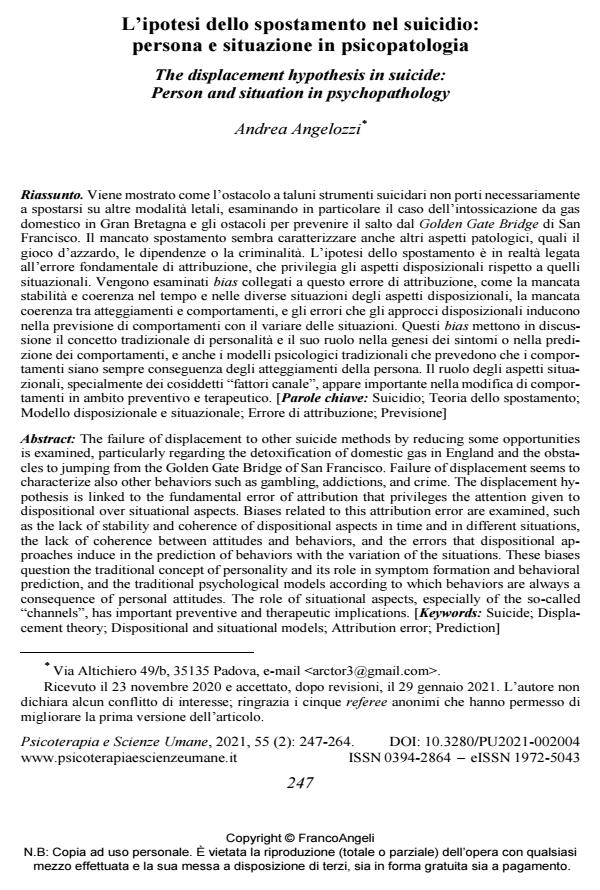L’ipotesi dello spostamento nel suicidio: persona e situazione in psicopatologia
Titolo Rivista PSICOTERAPIA E SCIENZE UMANE
Autori/Curatori Andrea Angelozzi
Anno di pubblicazione 2021 Fascicolo 2021/2
Lingua Italiano Numero pagine 18 P. 247-264 Dimensione file 434 KB
DOI 10.3280/PU2021-002004
Il DOI è il codice a barre della proprietà intellettuale: per saperne di più
clicca qui
Qui sotto puoi vedere in anteprima la prima pagina di questo articolo.
Se questo articolo ti interessa, lo puoi acquistare (e scaricare in formato pdf) seguendo le facili indicazioni per acquistare il download credit. Acquista Download Credits per scaricare questo Articolo in formato PDF

FrancoAngeli è membro della Publishers International Linking Association, Inc (PILA)associazione indipendente e non profit per facilitare (attraverso i servizi tecnologici implementati da CrossRef.org) l’accesso degli studiosi ai contenuti digitali nelle pubblicazioni professionali e scientifiche
Viene mostrato come l’ostacolo a taluni strumenti suicidari non porti necessariamente a spostarsi su altre modalità letali, esaminando in particolare il caso dell’intossicazione da gas domestico in Gran Bretagna e gli ostacoli per prevenire il salto dal Golden Gate Bridge di San Francisco. Il mancato spostamento sembra caratterizzare anche altri aspetti patologici, quali il gioco d’azzardo, le dipendenze o la criminalità. L’ipotesi dello spostamento è in realtà legata all’errore fondamentale di attribuzione, che privilegia gli aspetti disposizionali rispetto a quelli situazionali. Vengono esaminati bias collegati a questo errore di attribuzione, come la mancata stabilità e coerenza nel tempo e nelle diverse situazioni degli aspetti disposizionali, la mancata coerenza tra atteggiamenti e comportamenti, e gli errori che gli approcci disposizionali inducono nella previsione di compor-tamenti con il variare delle situazioni. Questi bias mettono in discussione il concetto tradizionale di personalità e il suo ruolo nella genesi dei sintomi o nella predizione dei comportamenti, e anche i modelli psicologici tradizionali che prevedono che i comportamenti siano sempre conseguenza degli atteggiamenti della persona. Il ruolo degli aspetti situazionali, specialmente dei cosiddetti "fattori canale", appare importante nella modifica di comportamenti in ambito preventivo e tera-peutico.
Parole chiave:Suicidio; Teoria dello spostamento; Modello disposizionale e situaziona-le; Errore di attribuzione; Previsione
- Folk psychiatry. La psichiatria fra immagine scientifica e psichiatria popolare Andrea Angelozzi, in PSICOTERAPIA E SCIENZE UMANE 3/2022 pp.431
DOI: 10.3280/PU2022-003004 - Intervento. La prevenzione del suicidio e l'accesso a metodi letali Maurizio Pompili, in PSICOTERAPIA E SCIENZE UMANE 2/2021 pp.265
DOI: 10.3280/PU2021-002005 - Problemi della previsione in psichiatria Andrea Angelozzi, in PSICOTERAPIA E SCIENZE UMANE 4/2021 pp.623
DOI: 10.3280/PU2021-004005
Andrea Angelozzi, L’ipotesi dello spostamento nel suicidio: persona e situazione in psicopatologia in "PSICOTERAPIA E SCIENZE UMANE" 2/2021, pp 247-264, DOI: 10.3280/PU2021-002004